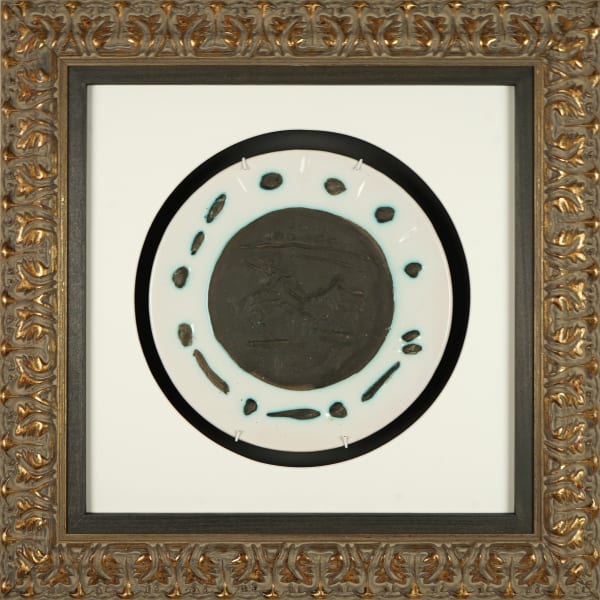Pablo Picasso
Framed: 60 x 50 cm
Further images
The Story of Picasso's Vollard Suite
The Vollard Suite is the crowning glory of Picasso's work as a printmaker. It was named for Ambroise Vollard (1866–1939) one of the most celebrated art dealers and publishers in late 19th and early 20th century Paris. In 1901 he had given Picasso his first solo exhibition in Paris, and later published two of his illustrated books. In 1934, he struck a deal with the artist to exchange paintings by Renoir and Cezanne for a series of one hundred etchings, along with their publishing rights.
Picasso worked on the project sporadically up until 1937, incorporating etchings that he had been producing since 1930 towards the final total. The spring of 1933 - when this piece was created - was a particularly rich period of activity, and some of the finest prints in the series were produced at this time. The etchings were not created with an overriding narrative in mind, but instead reflect Picasso's shifting obsessions and wider emotional state. Each one should be considered an independent, fully-realised work. Early images feature a sunlit arcadia, but over the course of his work on the prints, Picasso's marriage dissolved, civil war erupted in Spain and fascism spread throughout Europe, and the content of the images became darker.
Picasso learned new etching techniques during the production of the suite, progressing from simple line etchings through to burin, drypoint, aquatint and sugar-lift aquatint. Most of the prints were completed to Picasso's satisfaction in a single state, but others went through a more protracted evolution, with one etching being reworked as many as fourteen times.
Picasso completed the project with three portraits of Ambroise Vollard produced on a single day in 1937. He presented the finished copper etching plates to his master printer Roger Lacourière, who would work until 1939 to print the full series. Vollard himself was to pass away in a car accident in July 1939. At some point during the early 1940s, the print dealer Henri Petiet purchased the entire edition (minus the three final portraits) from Vollard’s estate.
A standard edition of 260 with small margins was printed, along with a deluxe edition of 50 on larger sheets of paper. Our etching comes from the standard edition. During the 1950s, Petiet persuaded Picasso to begin signing the etchings by hand. The artist was reluctant to do so, but he signed groups of the prints sporadically up until the late 1960s. Petiet would periodically visit Picasso with batches of etchings to be signed, generally starting with those that he felt were the most important and appealing. Due to this haphazard and protracted process, many prints from the Vollard Suite remain unsigned, and hardly any of the signed impressions are numbered.
A Rare Opportunity for Collectors
For collectors of Picasso's original limited edition prints, the Vollard Suite represents the last word in artistic quality and historical value. This hand-signed etching is a beautiful example of a portfolio that revolutionised modern printmaking.
Any questions? We are happy to help. Call: 0117 279 6402 or send us a message now.
- X
- Tumblr
Subscribe to receive our weekly newsletter.
* denotes required fields
Sign up now to get exclusive early access to new inventory before it hits our website. As a subscriber, you'll also receive advance notice about upcoming art fairs, events, and special offers. You can read our privacy policy here.
Galleries |
| Bristol |
This site uses cookies to give you the best possible experience. By clicking accept you are agreeing to our use of cookies. Find out more.
Subscribe to receive our weekly newsletter.
Be the first to know about new artwork, exhibitions, events and offers.
* denotes required fields
Sign up now to get exclusive early access to new inventory before it hits our website. As a subscriber, you'll also receive advance notice about upcoming art fairs, events, and special offers. You can read our privacy policy here.







